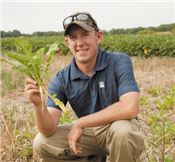|
Stewardship Options
Cover Crops, LibertyLink System Offer Ways To Be Better Stewards

BETTY VALLE GEGG-NAEGER
MidAmerica Farmer Grower
EWING, ILL.
The value of cover crops and LibertyLink soybeans was discussed by Jonathan Perkins, Southern Illinois practical farm research director and team sales agronomist for Beck Superior Hybrids. He also outlined some of the options his company offers.
“A few of the things we’re talking about are some different mixes of products that we have and what we’re trying to accomplish with those,” he said.
He also discussed the reasons for using cover crops as he addressed a group of students present at the field day.
“We’re trying to improve soil health for one thing, but we’re also trying to be better stewards of our nutrients, we’re trying to sequester nutrients as well as produce some nutrients like nitrogen in the soil with some of our different mixes. We have crimson clover, tillage radishes and other various products that are doing that for us.”
Through research mainly from the company’s central Illinois location, some different nitrogen management practices ranging from 100 percent rates compared to 75 percent and 50 percent rates of nitrogen.
“We’ve seen advantages to using cover crops over the top of no cover crop control,” he said. “So we’re working with more data on that. We have a one-year summary so far that has showed a positive response, especially to annual ryegrass, but we’re looking forward to getting more information in the future on that and are working with it at some of our other research locations in southern Illinois as well as our locations in Kentucky, Indiana and Ohio.
“We’re trying to be better stewards of our soil and minimize erosion, sequester nutrients and hopefully improve soil health and promote better soil activity.
“I want to just mention on the Liberty Link soybeans, we are talking about those today as a means to manage or minimize the weed resistance pressure,” he said. “That’s one of the tools that we have in the toolbox to work with the weed resistant issues especially marestail and waterhemp that are here in southern Illinois.”
One key point he mentioned is that the Liberty Link system is a different chemistry, a contact rather than systemic chemistry, so it’s different from glyphosate; therefore, farmers should consider using different practices.
“Then we also are using the LibertyLink system to rotate modes of action and to minimize the spread of resistance as we see it in the state. So overall we’re working to be better stewards by using better management practices so we can see a better return per acre for the farmer and our customers,” he summed. ∆
BETTY VALLE GEGG-NAEGER: Senior Staff Writer, MidAmerica Farmer Grower
|
|